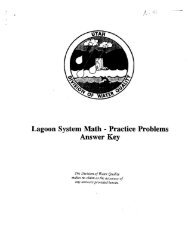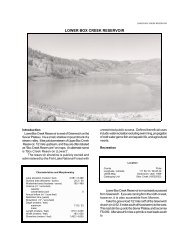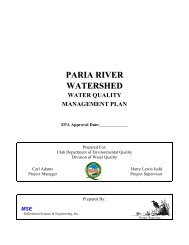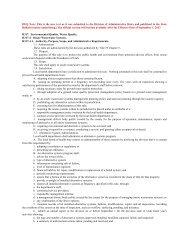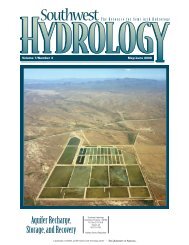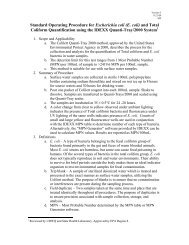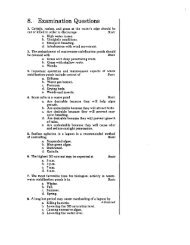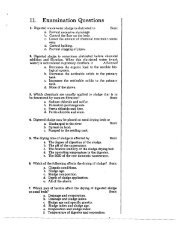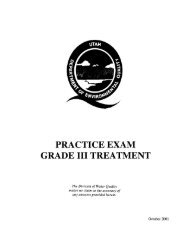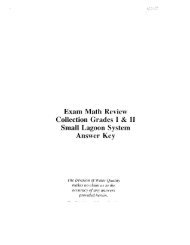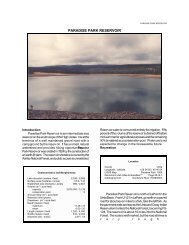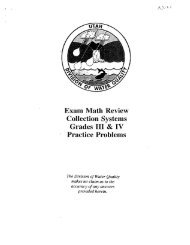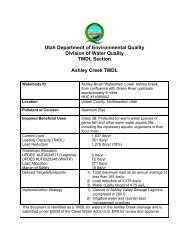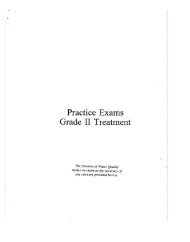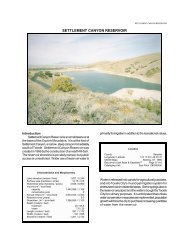Silver Creek - Division of Water Quality - Utah.gov
Silver Creek - Division of Water Quality - Utah.gov
Silver Creek - Division of Water Quality - Utah.gov
Create successful ePaper yourself
Turn your PDF publications into a flip-book with our unique Google optimized e-Paper software.
<strong>Silver</strong> <strong>Creek</strong> <strong>Water</strong>shed TMDL Final Report<br />
water, and surrounding soils. Isolation measures will be dictated by the extent <strong>of</strong> the<br />
contamination as well as physical characteristics <strong>of</strong> the contaminated area. Measures<br />
can range from construction <strong>of</strong> diversion swales/ditches to re-route run-<strong>of</strong>f, to<br />
removal <strong>of</strong> contaminated material and remediation <strong>of</strong> contaminated site. At a<br />
minimum, erosion control measures should be established to prevent run-<strong>of</strong>f from<br />
entering and contaminated sediments from leaving contaminated sites.<br />
• Treatment Measures – Contaminated flows can effectively be treated with the use <strong>of</strong><br />
man-made or naturally occurring wetlands, i.e. <strong>Silver</strong> Maple Claims. Flows can be<br />
routed into wetlands with the appropriately designed inlet/outlet structures to ensure<br />
adequate retention time for the biological removal <strong>of</strong> contaminants in the water<br />
column. Off–site or tributary flows, i.e. storm run-<strong>of</strong>f, can be treated using local<br />
storm water programs, i.e. UPDES. Storm water can be managed using proper<br />
erosion control measures, following guidelines as established by the state and Federal<br />
<strong>gov</strong>ernments, and ensuring that storm water controls are being applied as necessary.<br />
• Ordinances – Local and State ordinances require the use <strong>of</strong> erosion control measures<br />
during construction or other disturbance activities. The Park City Landscaping and<br />
Maintenance <strong>of</strong> Soil Cover ordinance (LMSC) requires that contaminated soils, at<br />
construction sites, be isolated either by capping onsite or removal to an approved site.<br />
Table 15 describes the types <strong>of</strong> BMPs recommended and contaminant removal efficiencies<br />
within each BMP category.<br />
Table 15: Best Management Practices – Description and Removal Efficiencies<br />
BMPs Description Removal References<br />
Efficiency<br />
Slope Protection<br />
(Stabilization)<br />
topsoil Imported topsoil placed at a minimum 84% Strock, 1998;<br />
depth <strong>of</strong> 1 foot, sometimes seeded<br />
and treated to promote growth <strong>of</strong><br />
vegetation.<br />
Georgia<br />
Stormwater<br />
Manual;<br />
Idaho BMPs<br />
Geotextile or matting<br />
revegetation<br />
hard surfacing<br />
Storm Run<strong>of</strong>f Routing<br />
grading to ensure positive<br />
drainage<br />
Matting or fabric placed on steeper<br />
slopes for erosion control and to<br />
promote vegetation growth.<br />
Seeding or placement <strong>of</strong><br />
seed/mulch/compost mixture to<br />
promote vegetation growth and slope<br />
stabilization.<br />
Pavement or other impermeable<br />
surface to prevent infiltration <strong>of</strong> water<br />
to contaminated soils.<br />
Site grading to deter storm water<br />
from pooling on or entering<br />
contaminated site.<br />
80% Georgia<br />
Stormwater<br />
Manual;<br />
Idaho BMPs<br />
84% Strock, 1998;<br />
Georgia<br />
Stormwater<br />
Manual;<br />
Idaho BMPs<br />
100% Georgia<br />
Stormwater<br />
Manual<br />
84% Strock, 1998;<br />
Georgia<br />
Stormwater<br />
Page 50



